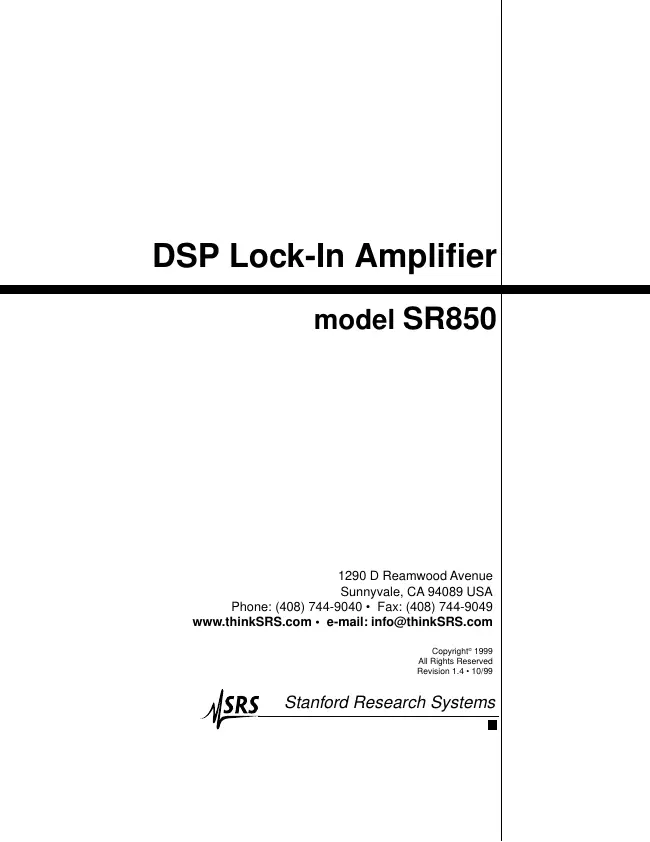SRS Stanford Research Systems - SR850 - Amplifier
Manufacturer:
No picture available!
Maybe you can
upload a pic
for the
SRS Stanford Research Systems SR850 ?
If you have any other manuals for the
SRS Stanford Research Systems SR850
you can
upload the files here.
.
Equipment:
SR850
Date:
1999
Category:
Group:
Sub Group:
Information
SIGNAL CHANNEL
Voltage Inputs Single-ended (A) or differential (A-B).
Current Input 106 or 108 Volts/Amp.
Full Scale Sensitivity 2 nV to 1 V in a 1-2-5-10 sequence
(expand off).
Input Impedance Voltage: 10 M½+25 pF, AC or DC coupled.
Current: 1 k½ to virtual ground.
Gain Accuracy ±1% from 20°C to 30°C (notch filters off).
Input Noise 6 nV/ÃHz at 1 kHz (typical).
Signal Filters 60 (50) Hz and 120(100) Hz notch filters (Q=4).
CMRR 90 dB at 100 Hz (DC Coupled).
Dynamic Reserve Greater than 100 dB (with no signal filters).
Harmonic Distortion <-90 dB to 10 kHz, <-80 dB to 100 kHz.
REFERENCE CHANNEL
Frequency Range 1 mHz to 102 kHz
Reference Input TTL (rising or falling edge) or Sine.
Sine input is1 M½, AC coupled (>1 Hz). 400 mV pk-pk minimum
signal.
Phase Resolution 0.001°
Absolute Phase Error <1°
Relative Phase Error <0.001°
Orthogonality 90° ± 0.001°
Phase Noise External synthesized reference: 0.005° rms at 1
kHz, 100 ms, 12 dB/oct.
Internal reference: crystal synthesized, <0.0001° rms at 1 kHz.
Phase Drift <0.01°/°C below 10 kHz
<0.1°/°C to 100 kHz
Harmonic Detect Detect at Nxf where N<32767 and Nxf<102 kHz.
Acquisition Time (2 cycles + 5 ms) or 40 ms, whichever is
greater.
DEMODULATOR
Zero Stability Digital displays have no zero drift on all
dynamic reserves.
Analog outputs: <5 ppm/°C for all dynamic reserves.
Time Constants 10 μs to 30 s (reference > 200 Hz). 6, 12,
18, 24 dB/oct rolloff.
up to 30000 s (reference < 200 Hz). 6, 12, 18, 24 dB/oct
rolloff.
Synchronous filtering available below 200 Hz.
Harmonic Rejection -90 dB
INTERNAL OSCILLATOR
Frequency 1 mHz to 102 kHz.
Frequency Accuracy 25 ppm + 30 μHz
Frequency Resolution 5 digits or 0.1 mHz, whichever is greater.
Frequency Sweeps Linear and Log.
Distortion f<10 kHz, below -80 dBc. f>10 kHz, below -70
dBc.1 Vrms amplitude.
Output Impedance 5 0 ½
Amplitude 4 mVrms to 5 Vrms (into a high impedance load)
with 2 mV resolution.
(2 mVrms to 2.5 Vrms into 50½ load).
Amplitude Accuracy 1%
Amplitude Stability 50 ppm/°C
Outputs Sine output on front panel. TTL sync output on rear
panel.
When using an external reference, both outputs are phase
locked to the
external reference.
INPUTS AND OUTPUTS
Channel 1 Output X, R,
q, or Trace 1-4. Traces are defined as A•B/C or A•B/C2 where
A, B,
and C are selected from the quantities Unity, X, Y, R,
q, Xnoise, Ynoise,
Rnoise, Aux Inputs 1 through 4, or Frequency.
Output Voltage: ±10 V full scale. 10 mA max output current.
Channel 2 Output Y, R,
q, or Trace 1-4. Traces are defined as A•B/C or A•B/C2 where
A, B,
and C are selected from the quantities Unity, X, Y, R,
q, Xnoise, Ynoise,
Rnoise, Aux Inputs 1 through 4, or Frequency.
Output Voltage: ±10 V full scale. 10 mA max output current.
X and Y Outputs Rear panel outputs of cosine (X) and sine
(Y) components.
Output Voltage: ±10 V. 10 mA max output current.
Aux. Outputs 4 BNC Digital to Analog outputs.
±10 V full scale, 1 mV resolution. May be set to a fixed
voltage or swept in
amplitude (linear or log). 10 mA max output current.
Aux. Inputs 4 BNC Analog to Digital inputs.
Differential inputs with1 M½ input impedance on both shield
and center
conductor. ±10 V full scale, 1 mV resolution.
Trigger Input TTL trigger input triggers each data sample
and/or start of scan.
Monitor Output Analog output of signal amplifiers (before
the demodulator).
DISPLAYS
Screen Format Single or dual display.
Displayed Quantities Each display may show one of the traces.
Traces are defined as A•B/C or A•B/C2 where A, B and C are
selected from
the quantities Unity, X, Y, R,
q, Xnoise, Ynoise, Rnoise, Aux Inputs 1
through 4, or Frequency.
Display Types Large numeric readout with bar graph, polar
graph, and strip chart.
Chart Data Buffer 64k data points may be stored and
displayed on strip charts. The buffer can
be configured as a single trace with 64k points, 2 traces
with 32k points
each, or 4 traces with16k points each. The internal data
sample rate ranges
from 512 Hz down to 1 point every 16 seconds. Samples can
also be
triggered.
ANALYSIS FUNCTIONS
Smoothing 5 - 25 point Savitsky-Golay smoothing of trace
regions.
Curve Fits Line, Exponential, and Gaussian fits of trace
regions.
Calculator Arithmetic, trigonometric, and logarithmic
calculations on trace regions.
Statistics Mean and standard deviation of trace regions.
GENERAL
Monitor Monochrome CRT. 640H by 480V resolution.
Adjustable brightness and screen position.
Interfaces IEEE-488, RS232 and Printer interfaces standard.
All instrument functions can be controlled through the
IEEE-488 and RS232
interfaces. A PC keyboard input is provided for additional
flexibility.
Preamp Power Power connector for SR550 and SR552 preamplifiers.
Hardcopy Screen dumps to dot matrix and HP LaserJet
compatible printers. Data
plots to HP-GL compatible plotters (via RS232 or IEEE-488).
Screens can
also be saved to disk as PCX image files.
Disk 3.5 inch DOS compatible format, 720 kbyte capacity.
Storage of data and setups.
Power 60 Watts, 100/120/220/240 VAC, 50/60 Hz.
Dimensions 17"W x 6.25"H x 19.5"D
Weight 40 lbs.
Warranty One year parts and labor on materials and workmanship.
User manual
Manual type:
User manual
Pages:
279
Size:
762.2 KB
Language:
english
Revision:
1.4
Manual-ID:
Date:
October 1999
Quality:
Electronic document, no scan, very well readable.
Upload date:
Jan. 1, 2017
MD5:
1c3e9376-73ab-5871-98d7-8581e5f5a537
Downloads:
468
